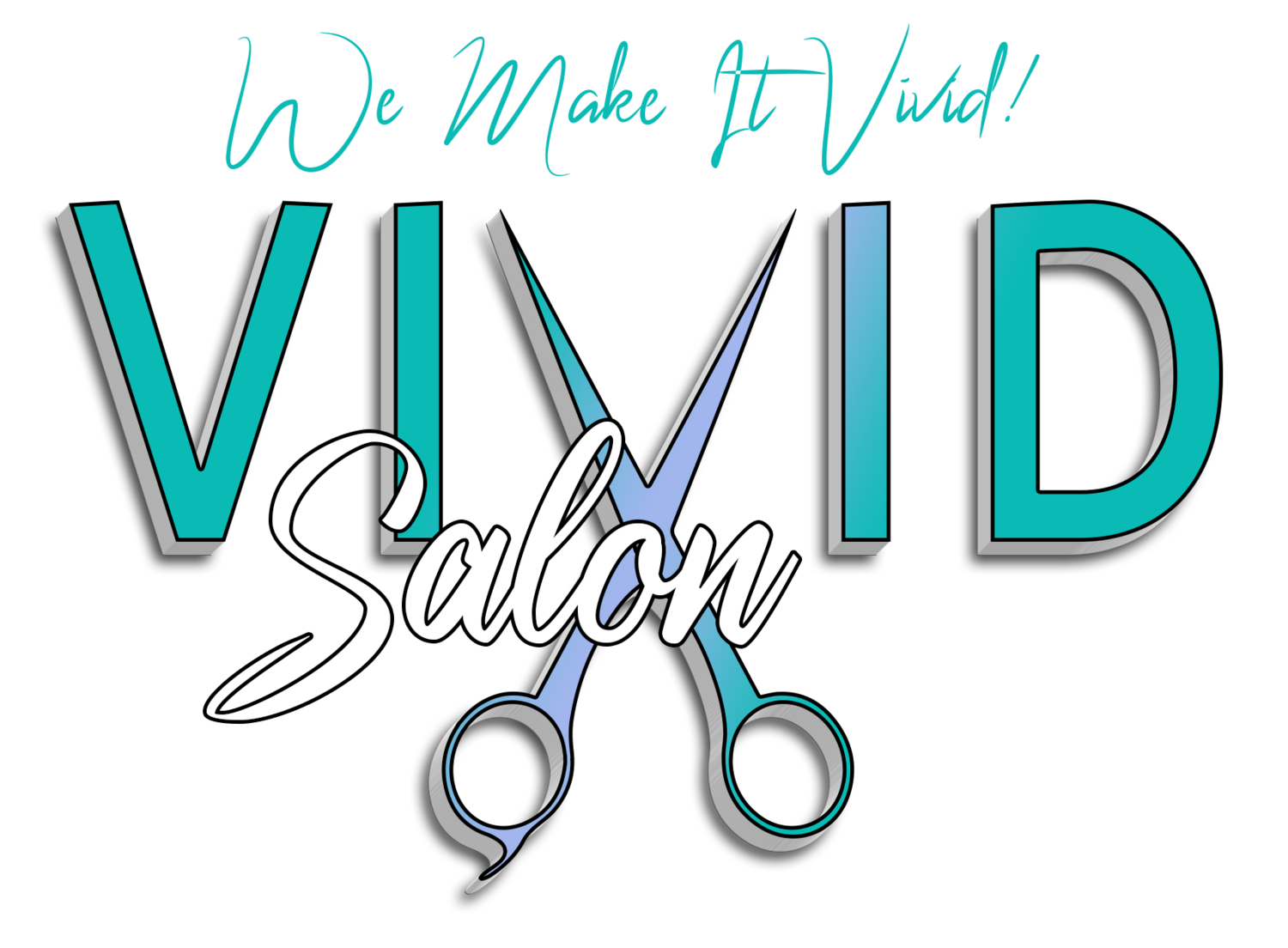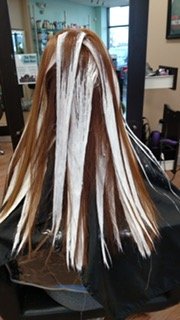Anxious about having Lightener/ Bleach on your hair? Lose the fear and Trust your Hairstylist!
Have you ever had a bad experience with a hair color session that terrified you to have lightener/ bleach put on your hair? Are you worried your hair can break from using lightener/ bleach on your hair? Have you been concerned about how your hair feels after receiving a lightening session? These are all valid concerns when using chemicals on your hair, but I’m here to tell you if you have the right salon professional taking care of your hair you will never have to worry about these situations. After working 20 years in the industry, I’ve seen it all! Let’s look at the difference between a lightener and permanent hair color, what causes the hair to get damaged, mistakes stylists make, consultation, and how you can keep your hair healthy after a lightening service.
What’s the Difference between Permanent Haircolor Vs. Lightener/ Decolorizer/ Bleach?
Knowing which product to use to create the looks your client wants to achieve will help determine the technique you choose to use. Permanent hair color is a chemical we use with peroxide to lift and deposit into the hair to change the melanin or color of the hair. “ When using Permanent hair color the cuticle must open first to allow the hair color to deposit. After the cuticle is open the dye reacts with the cortex of the hair to deposit or remove hair color. This process is similar to using a lightener except a colorant is bonded to the hair shaft. In permanent hair color, the color contains ammonia and it is added to the developer to oxidize the hair color. The ammonia opens up the cuticle and the peroxide removes the previous hair color.” (Helmenstine, Anne Marie. 2020)Permanent hair color allows us to lift the hair up to 4 levels. This is a great product choice when covering grey hair, changing virgin hair color, or shifting the hair color. High-lift permanent hair color allows some extra lift but will not remove hair color from the hair and will not provide maximum lifting.
Lightener/ Bleach/Decolorizer allows us to lighten the hair up to 8 levels in 55 minutes. Lightener is the best product choice when needing maximum lifting or when removing artificial pigment from the hair. According to Redken Artist Lori Zabel, “When Hydrogen peroxide is mixed with lightener it changes the melanin structure and lightens the color of the hair. This is done by breaking down the tiny pigments into fragments, which are no longer able to absorb light to the same degree as before. The hair then goes through predictable color changes as the pigment disperses and slowly lightens from level to level. The longer the mixture stays in the hair the more the melanin is changed and the lighter the hair becomes.” Depending on the starting level the hair has to go through a series of undertones to reach the lightest level. For example, if the client's hair is a natural level 5 brown the first undertone exposed is red, then red/orange, then orange, then orange/yellow, yellow, and pale yellow. Dark brown hair goes through the most amount of changes whereas lightest brown hair goes through fewer changes. Hair should not be lightened past the pale yellow stage because it can damage the protein bonds in the cortex of the hair.
What causes damage to the hair?
Overprocessing the hair. Whether you overlap the lightener you risk causing breakage to the hair. Is this necessary? Sometimes we have to overlap previously lightened hair to achieve maximum results. However, there are safe approaches to doing this and the professional should explain this during the consultation.
Coloring on overprocessed hair without pretreating it. Can you use chemicals on previously color-treated hair? Absolutely you can. However, providing a series of treatments may be necessary to strengthen the hair prior to the chemical treatment and after the service is provided.
Using high heat on chemically treated hair without heat protectants.
Can you avoid causing a change to the texture of the hair? Only natural hair that has never been color-treated or heat-treated can remain healthy without the use of products.
Mistakes stylists make.
Not providing a thorough consultation and overpromising and underdelivering.
Not pretreating the hair. Sometimes our clients need to strengthen their hair prior to receiving a hair color service. Maintaining the integrity of the hair during a chemical service is very important.
Overlapping lightener on the hair every time the client receives a lightening service versus only retouching the highlights or hair color when they return for a touch-up.
Not providing post-treatments to the hair to replenish the hair with moisture and strength that it lost during the chemical service.
When a client has fragile or compromised hair it's okay to say this is not the best option for their hair. If it will compromise the hair further it's best to just help them rebuild their hair versus causing more damage.
Forgetting to recommend at-home haircare to continue keeping the hair healthy.
Consultation
The most important step in this process is to have a thorough consultation. When a client is anxious about using lightener on their hair it’s best to discuss all the possible solutions to achieving the look they want with the least amount of damage to the hair. During the consultation, the stylist will asses the hair length, texture, abundance, and condition/porosity. The stylist is able to learn about hair history and determine the natural level, and undertones that will be exposed. After the assessment, the stylist knows what they need to do to achieve the look. They will discuss the necessary maintenance for the look and what you need to use at home to keep the integrity of the hair in good condition. Any time a chemical service is provided the hair changes physically. During the hair color process, the melanin in the hair strand is broken down to change the natural color. This can cause the texture of the hair to change as well. Once you and your hairstylist decide on the best plan for your hair you shouldn’t be worried about breakage in your hair, or how your hair will feel after a lightening service, and overall will have a better experience when receiving a lightening service.
Ways to keep your hair healthy after having a Lightening session
Get a monthly Salon hair treatment. There's nothing more relaxing than having an amazing shampoo, a treatment put on your hair, and a hot towel to relax in the shampoo room. You don’t have to wait until your next hair appointment to treat your hair. Take advantage of replenishing your hair and then getting a nice blowout afterward.
Try a Keratin smoothing treatment. This not only makes the hair more manageable but will infuse the hair with protein to repair your hair.
Use the appropriate temperature on heat tools. High heat on heat tools not only breakdown the hair strands, but also fades your hair color faster. Too much heat without using a heat protectant on your hair causes damage to your hair.
Use the products your stylist recommends. Hairstylists recommend shampoo, conditioner, treatments, and styling products to maintain the integrity of the hair at home. This is not a gimmick and believe me when I say this the salon professional recommends products they are educated on that they know can help you achieve the look you want at home. Ever want to take your stylist home with you? You can simply by using what they use on your hair.
Reserve appointments in advance to maintain the look your stylist created for you. Having a regular haircut will keep eliminate dead hair that needed to go. Maintaining your hair color keeps the hair looking shiny and even.
Stop taking advice from non-hair-professionals about how to take care of your hair. Would you take medical advice from your Lawyer? I mean maybe you would, but the professionals in that line of work spend countless hours educating themselves on how to have fantastic hair.
Sit in the right hairstylist's chair to never feel uncomfortable about the process that is about to happen. Make a reservation today with one of our Talented professionals.
Til Next time! Mwah!
References:
Helmenstine, Anne Marie, Ph.D. "The Science of Hair Coloring." ThoughtCo, Aug. 27, 2020, thoughtco.com/salon-hair-color-chemistry-602183.
Zabel, Lori. (n.d.) How does lightener work? https://us.lorealaccess.com/learn/course/25281/how-does-lightener-work-redken






